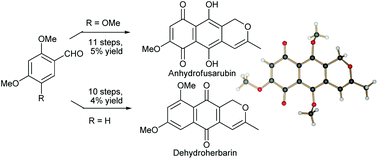The synthesis of two closely related pyranonaphthoquinones, dehydroherbarin and anhydrofusarubin, is described. The construction of the naphthalene nuclei was achieved using the Stobbe condensation reaction using 2,4-dimethoxybenzaldehyde and 2,4,5-trimethoxybenzaldehyde as their respective starting materials. Two key steps en route include a PIFA-mediated addition of a methoxy substituent onto the naphthalene skeleton and a Wacker oxidation reaction to construct the benzo[g]isochromene nucleus. Two interesting oxidation reactions of the intermediate isochromene enol ether of 7,9-dimethoxy-3-methyl-1H-benzo[g]isochromene-5-ol were observed. Treatment of the substrate with salcomine resulted in the formation of (3-formyl-4-hydroxy-6,8-dimethoxynaphthalene-2-yl)methyl acetate, while treatment of the same substrate with CAN resulted in the formation of racemic (3R,4R)-3-hydroxy-7,9-dimethoxy-3-methyl-5,10-dioxo-3,4,5,10-tetrahydro-1H-benzo[g]isochromen-4-yl nitrate.
You have access to this article
 Please wait while we load your content...
Something went wrong. Try again?
Please wait while we load your content...
Something went wrong. Try again?


 Please wait while we load your content...
Please wait while we load your content...